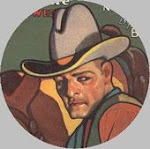One of the Press' books I read recently
was Down the Santa Fe Trail and into Mexico: The Diary of Susan
Shelby Magoffin, 1846-1847. I have some interest in the Santa Fe
Trail, and when I found this volume on the library's Sale cart, I
thought it would be a handy reference.
Well, it is, But when I began reading it, I had no idea
I was also going to be immersed in lots of Kentucky history, as well.
Susan Shelby Magoffin (July 30, 1827 –
October 26, 1855) was tied to two families important to frontier
history. Really, more than two.
She was the granddaughter of Isaac Shelby (December 11,
1750 – July 18, 1826), a hero of the American Revolution and the
first and fifth governor of Kentucky. She was born near Danville,
Kentucky. She was named for an aunt, who was married to Dr. Ephraim McDowell (November
11, 1771 – June 25, 1830), a Danville physician famed for
performing the world's first successful ovarian tumor removal by surgery. (The tumor weighed 22.5 pounds!)
At the time of the journey, Susan was
18 years old and had been married only eight months to frontier
merchant Samuel Magoffin, whose family also hailed from Kentucky. One
of Susan's sisters was married to Beriah Magoffin, 21st
governor of Kentucky. Samuel's brother – and Susan's brother-in-law
– James played an important role during the journey recounted in
Susan's journal, serving as an emissary of the United States
government to deal with the Mexican authorities as the Army
advanced—because, while the Magoffins made their business trek to
Santa Fe, the U.S. Army was battling the Mexican Army in efforts that
would eventually expand the United States' border to the Rio Grande
to include he Republic of Texas and New Mexico.
So Susan met another famous Kentuckian
on her trip: Zachary Taylor (November 24, 1784 – July 9, 1850),
General of the Army at the Battles of Monterrey and Buena Vista,
afterwards known as Old Rough and Ready, and eventually elected as
the 12th President of the United States.
Susan is quite proud of her Kentucky
heritage, and she continually compares the men she meets during her
trip with the Fine Kentuckian Qualities of the men she knows back
home. For example, while in Santa Fe . . .
On leaving the Fort we rode to the
opposite side of the city (to the West) to see the Gloriatta, an
inclosed public walk. It was commenced by Gov. Gen. Garcia Conde,
being planted altogether in indifferent looking Cotton-woods it is
quite susceptible of improvement—a Yankee's ingenuity and
Kentuckian's taste is wanting to make it a beautiful place. (pp.
141-142)
While in Santa Fe, she is visited by a
number of the military men. To one such visitor, Susan says,
I complimented him a little and my own
dear Kentucky, at the same time by asking him, for my own private
information, if he [came] from Ky. as I believed most or all of the
great men were from there, or connected with her in some way. (132)
Susan's allegiance to her home state
sound a bit funny to our ears. But really, people today have local
and state pride; and the boosters of college sports teams aren't so
much different today. (SEC fans may be a bit more zealous.) But her
biases aside, her journal provides a remarkable record of the time
for a civilian caught in a war zone while the U.S. invades Mexico.
The worries – for loved ones captured or for her immediate family,
when rumors reach them that the enemy is approaching and killing all
Anglos – and the delights of her journey are presented with details
that military and business-oriented accounts overlook or have no
concerns for. The details of the journey – the number of hours of travel, the
stops for water or rest or repairs, the description of the landscape and its features,
the difficulties of living on the trail – are wonderful for those
who seek that sort of information, and her descriptions lift the
Santa Fe Trail from being a dry historical subject to something alive
and real.
Susan's place in history as the first
Anglo woman to travel the Trail and journey into Mexico with the
traders is made all the more important by her journal, which gives
the modern reader a look at the War with Mexico, a wonderful view of
travel and work on the Sante Fe Trail, and a sense of what people
from North American culture experienced when they first encountered
the South of the Border culture during the 1840s.
I heartily recommend this book.






